A modern dive watch is defined through its dive bezel. It's the aesthetic feature that makes it stand out the most. However, dive or count-up bezels and not even the revolving functionality have been invented for commercial diving. Their history starts a good 25 years before the first Rolex Turnograph was presented. And it went through quite some changes, too.
February 29, 2024
The Rotational Bezel - It's Not Just Dive Watches

Marcus Siems @siemswatches
Collector, Author, Data Analyst
What defines a dive watch? After you've mentioned "water-resistant, duh!", "made from steel" and maybe even "legible dark dial" your attention is probably drawn towards the bezel. And that's probably a design feature of this genre that's makes it stand out the most against all other horological categories. It's really somewhat the unique selling point for modern dive watches from an aesthetic perspective.
 The archetypical watch that comes to mind to sport a rotational bezel... a dive watch. And this one started it all in our modern perspective: The 1953 Rolex "Turnograph" (or a rare Monometer in this case). Photo Courtesy of Antiquorum.
The archetypical watch that comes to mind to sport a rotational bezel... a dive watch. And this one started it all in our modern perspective: The 1953 Rolex "Turnograph" (or a rare Monometer in this case). Photo Courtesy of Antiquorum.
But as you might have figured out already the story of the rotational bezel doesn't start in a dive watch - the 1953 Rolex Turnograph 6202 - but over 20 years earlier in another element. As much as this simple construction complication can help you navigate your descend and ascend underwater it was first introduced as an aid for aviation pioneers on long flights. So let's start our deep-dive into the non-diving roots of the rotational bezel.
Chapter 1: The Longines Weems & Lindbergh Hour Angle (1929)
Long story short, the rotational bezel was originally designed to help pilots navigate. In our world of smartphones and GPS it's quite easy to get from A to B but a good 100 years ago that wasn't really an option. People had to rely on maps and in aviation - without roads - it could get even more complicated as you'd have to rely on a compass and closely monitoring your speed... Imagine flying over the open sea without any landmarks in sight. Quite unnerving!
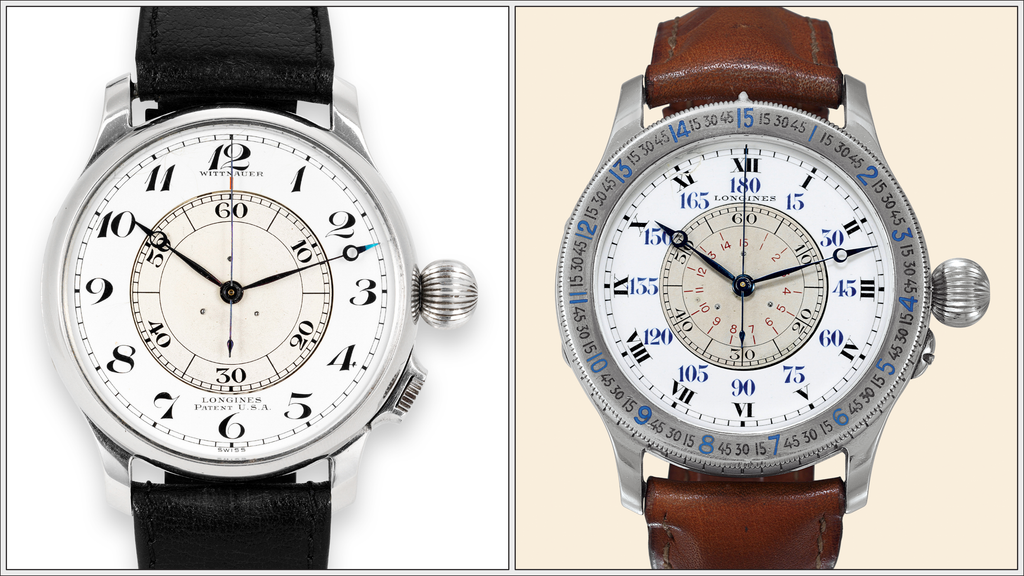 Longines/Wittnauer pilot watch creations of the 1920s & 30s. The Weems with center-dial (left) and Lindbergh's upgrade with the Hour Angle watch (right). Photos Courtesy of Antiquorum.
Longines/Wittnauer pilot watch creations of the 1920s & 30s. The Weems with center-dial (left) and Lindbergh's upgrade with the Hour Angle watch (right). Photos Courtesy of Antiquorum.
Navigating was difficult, it was a matter of life and death... In other words any pilot had a strong interest in navigation tools to improve their chances to safely find their way home. Not surprisingly several innovations in watchmaking came in collaboration with pilots*. In 1927 Longines partnered with American pilot Philip van Hoorn Weems[1-2]. Weems had an idea how to synchronize his watch with second-precision to ground-based radio time signals without having to re-set his watch entirely: An center-dial that could be rotated by an additional crown at 4 (see above).
The Weems was developed in 1929... but that's of course not a rotational bezel. It took another aviator to add this upgrade. Charles Lindbergh - the first man to cross the Atlantic Ocean in a plane - reached out to Longines to improve the Weems model and added the Hour Angle bezel to it[1-2]. A great deal of their history and function can be seen here in Cole Pennington's - watch and aviation nerd - encounter with one of the largest pilot's watch collections from a couple years back:
Watches In The Wild | Thailand, Ep. 2: One Of The World’s Greatest Pilot’s Watch Collections. A video with courtesy of Hodinkee.
The Lindbergh Hour Angle was introduced in 1931 and thus is the birth year of the rotational bezel on wristwatches.
Chapter 2: Movado's Chronoplan & Rolex's Zerographe (1937)
Let's come back to something more intuitive to use. In all fairness, the Longines models functionality was extremely niche and their bezels were made for this particular purpose. So in this chapter we'll have a closer look at the first more classic "count-up" bezel styles.
It's super simple: You rotate the bezel such that the zero marking aligns with your minute hand (or second hand) et voila you can read off intermediate timing intervals.
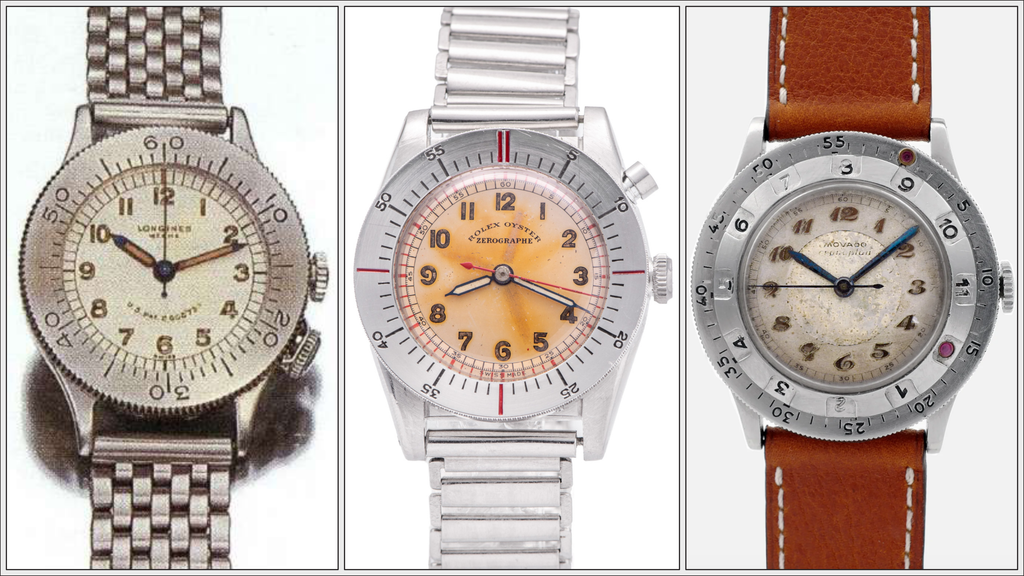 Three examples of late 1930s watches with revolving bezel-styles. Longines Weems chrongraph (left), Rolex Zerographe (middle), and Movado Chronoplan (right). Photos Courtesy of Antiquorum and The Time Curator.
Three examples of late 1930s watches with revolving bezel-styles. Longines Weems chrongraph (left), Rolex Zerographe (middle), and Movado Chronoplan (right). Photos Courtesy of Antiquorum and The Time Curator.
During the late 1930s we can see similar developments at Longines, Rolex and Movado. All three brands are presenting timepieces with revolvable count-up bezels. An evolution of Longines Weems under U.S. patent 2008734, Movado's Chronoplan with double-revolving bezels (minutes and hours; 1937) and their Tempograf chronograph (1939), as well as Rolex's Zerographe and Centregraphe (ref. 3346; 1937).
All of these are very interesting examples in their very own right. The Rolex Zerographe (ref. 3346) for example was not only the first Rolex with rotational bezel but also one of the first "complicated" Rolex featuring a 10 1/2" chronograph movement. An enigma in the Rolex collector's community of which less than 50, potentially less than 25 have been made - ever.
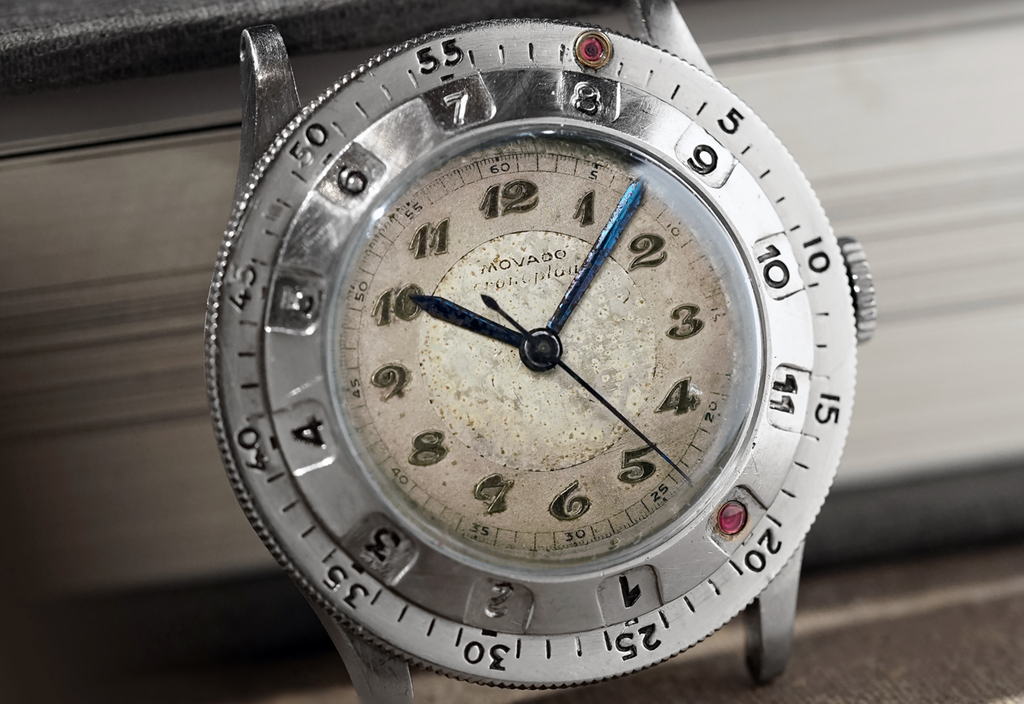 One of Movado's most simplistic yet ingenious inventions - the double-revolving bezel to track minutes and hours without resetting the time or utilizing a chronograph module. Photo Courtesy of The Time Curator.
One of Movado's most simplistic yet ingenious inventions - the double-revolving bezel to track minutes and hours without resetting the time or utilizing a chronograph module. Photo Courtesy of The Time Curator.
The Movado Chronoplan is another intriguing example from the bunch. It extended the idea of the revolving bezel to a three-handed time-only watch. By doing so it created the possibility to function as a stop-watch without the mechanical chronograph complication! Quite a clever workaround.
Chapter 3: Breitling Chronomat (1942)
After we've seen how basic and simplistic a revolving bezel can be used we're switching gears again to one of the most "complicated" watches that is not a Grand Complication. I'm of course speaking about the 1942 Breitling Chronomat (ref. 769 with Venus 175, patent No. 217012) - a model name that's derived from "Chronograph" and "Mathematics"[3-4]. It's a watch for which you should keep the manual to make use of all its functions...
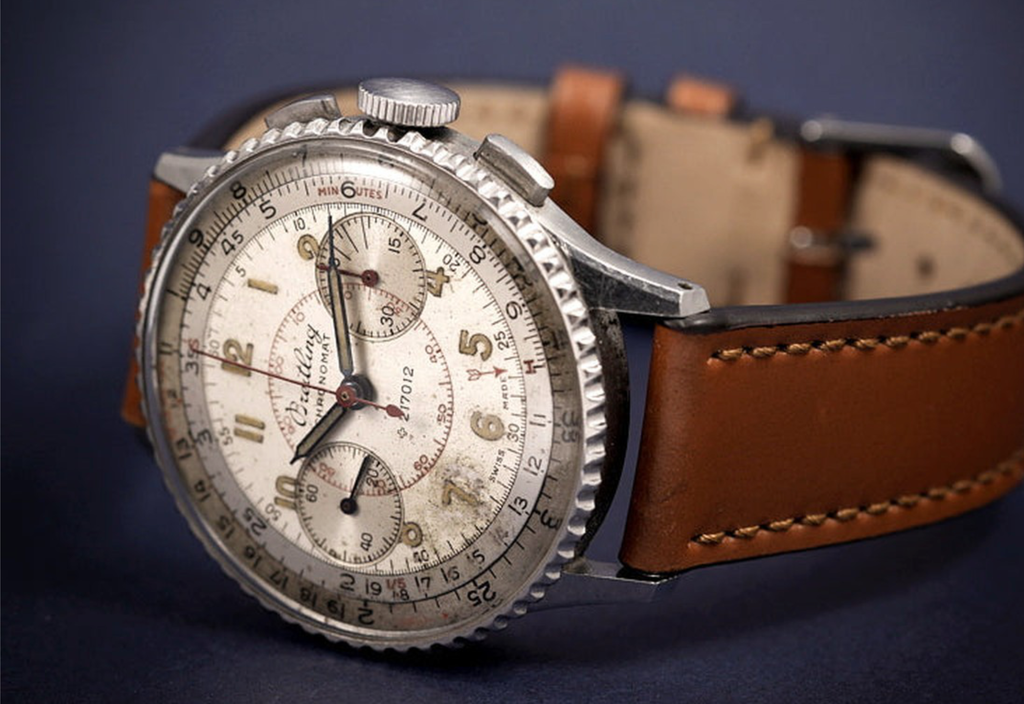 A 1940s Breitling Chronomat ref. 769. The slide-rule bezel can be rotated to do arithmetics on timing intervals or other simple computations for several professions. Photo Courtesy of Karp Watches Expertise.
A 1940s Breitling Chronomat ref. 769. The slide-rule bezel can be rotated to do arithmetics on timing intervals or other simple computations for several professions. Photo Courtesy of Karp Watches Expertise.
In a nutshell, the bezel on the Chronomat is a slide-rule to reorient the inner scale which can be used to solve several mathematical computations. Even simple equations can be solved using this functionality - simply by utilizing a revolving bezel...
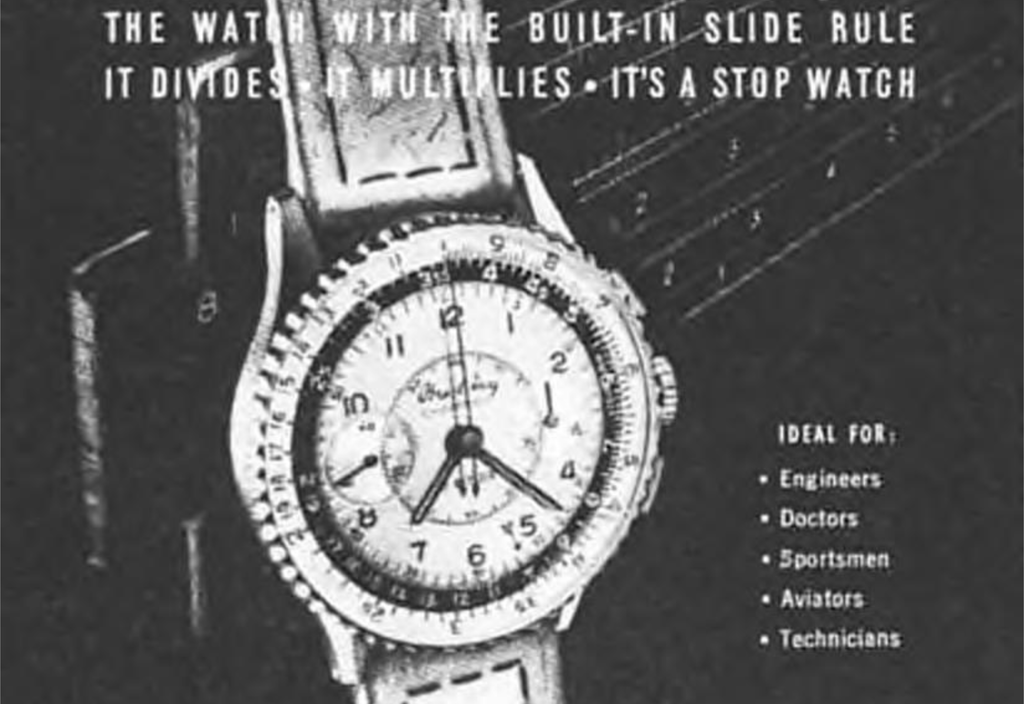 A 1948 advertorial on the Breitling Chronomat and all its functions: "It Divides - It Multiplies - It's A Stop Watch". Photo Courtesy of HIFI Archiv.
A 1948 advertorial on the Breitling Chronomat and all its functions: "It Divides - It Multiplies - It's A Stop Watch". Photo Courtesy of HIFI Archiv.
Chapter 4: Rolex Turnograph (1953)
With the emerging fields of commercial and recreational diving the need for timing equipment grew. With saturation diving you'd need to closely monitor your ascend back to the surface. If you go up too quickly, nitrogen bubbles form in your blood vessels and can lead to serious complications - decompression sickness.
But conditions in deep water are not only threatening to the human body but the functioning of a watch as well. Particularly, chronograph pushers are the weakest link in sealing a watch case against the elements. Timing your ascend with a stopwatch was thus rather impractical... And so the focus went back the format proposed by Movado's Chronoplan 16 years prior - a time-only watch with revolving bezel - this time on a water-resistant case. The birth of the classic dive watch look
 The first "modern" dive watch was created by Rolex and introduced in 1953 - the reference 6202 Turnograph with uni-directional bezel. Photo Courtesy of Menta Watches.
The first "modern" dive watch was created by Rolex and introduced in 1953 - the reference 6202 Turnograph with uni-directional bezel. Photo Courtesy of Menta Watches.
The clue and the novelty factor about Rolex's newly introduced Turnograph ref. 6202 (1953, Submariner 1954) was the unidirectional bezel. For the first the bezel could revolve only in one direction to prevent the diver to accidentally set the bezel forward and ascent too quickly. A small step in the evolution of the rotational bezel but a giant leap in keeping saturation divers alive.
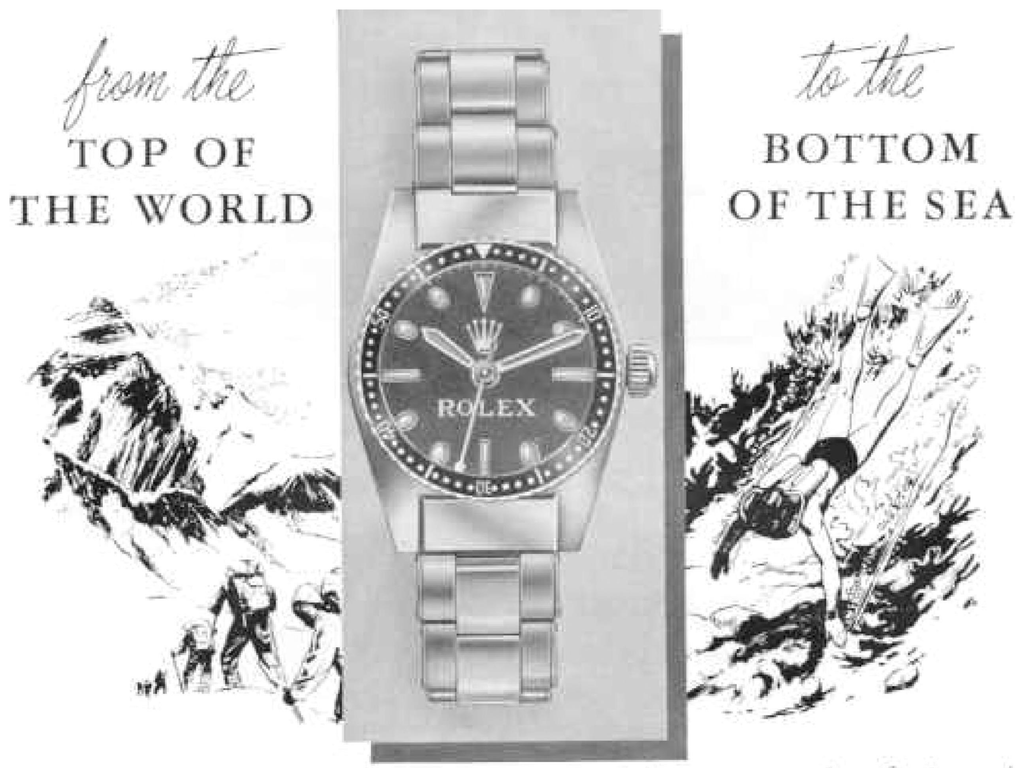 The ingenuity of the Rolex marketing department. Here you can see an advertorial on the Bathyscaphe Trieste submersible that brought a Rolex "Submariner" with it from 10,350 feet below surface. Advertorial Courtesy of HIFI Archiv.
The ingenuity of the Rolex marketing department. Here you can see an advertorial on the Bathyscaphe Trieste submersible that brought a Rolex "Submariner" with it from 10,350 feet below surface. Advertorial Courtesy of HIFI Archiv.
Bonus Chapter 5: Heuer Autavia 1163 (1969)
We more or less captured the full evolution of the revolving bezel in terms of functionality but an additional innovation might have come in 1969. The Autavia ref. 1163 may not only have been the first automatic Autavia[5] but also featured the first lockable bi-directional bezel[6]... But be aware the evidence on this aspect is relatively thin.
Conclusion
I find it remarkable how easy we as humans accept the world around us as quasi-static, not questioning if it ever was any different. We all use smartphones today, but how often do you still think about how it's been before? Before information and a pizza was just a finger movement away?
 This is how dive watches in the early days used to look like... An anonymous Rolex/Panerai ref. 3646 from 1946 with error-proof ("California") dial. Photo Courtesy of Sotheby's.
This is how dive watches in the early days used to look like... An anonymous Rolex/Panerai ref. 3646 from 1946 with error-proof ("California") dial. Photo Courtesy of Sotheby's.
Dive watches have "dive watch bezels" (aka count-up bezels) what else would you use them for if not for diving? Well, revolving bezels were used for navigation, generally timing intervals and even mathematical computations before they were actually used in a dive watch**.
- A big thank you goes to Alfonso Brivio (@mr_fons_) from the The Time Curator for providing the images on his stunning Movado Cronoplan -
* Well, even the very first men's wristwatch was a pilot's watch - A Cartier for Alberto Santos-Dumont.
** One might argue that the Zerographe (1937) was a dive watch because it came in an Oyster case... Clear no from me as it is only a sentimental diver but not a functional one.
References
[1] The History of the Pilot's Watch Part Four - Longines and Lindbergh; Max E. Reddick, Monochrome Watches [Link]
[2] The Science, History, And Romance Behind The Longines Lindbergh Hour Angle Watch; Jack Forster, Hodinkee [Link]
[3] Breitling Chronomat - A Short History, Part 1; Altro, WatchUSeek [Link]
[4] Breitling Chronomat - The Watch To Save The Company; Marcus Siems, Goldammer Vintage Watches [Link]
[5] Autavia Reference Table; Jeff Stein, OnTheDash [Link]
[6] Charlie Dunne; Personal Correpsondence
All rights on text and graphics reserved to the Author.




























Leave a comment